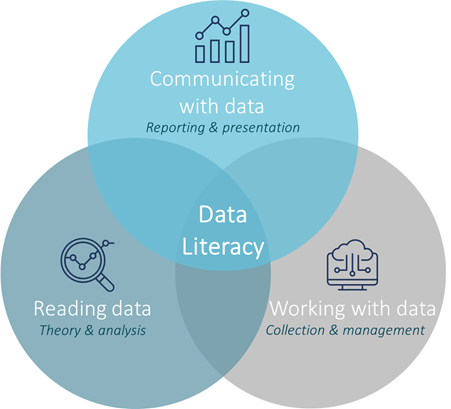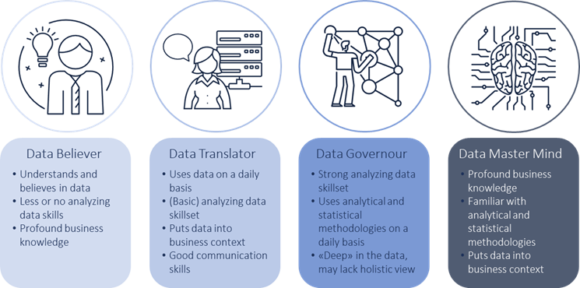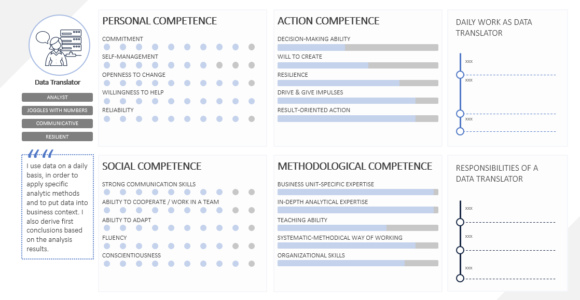You’ve probably heard following statements a million times: “information is an asset”, “we have to make evidence-based decisions” or “we need analytics to become one of our main competencies.”
Needless to say that we all know that to a certain extent. But the “how to get there” is often quite a messy approach or it is taken for granted that employees will acquire data literacy competencies by just doing their job. This is a topic that has been teasing our brains at CAMELOT for a long time and we have put our experience and knowledge together to come up with an approach that will help you and everyone else to become more data literate.
What is Data Literacy
Let’s have a short recap of what data literacy means. In our former blog article “Data Literacy: why it is needed” our colleagues Henrik and Geron described data literacy as “the ability to read data, work with data, and communicate about data by putting it in the right context.” Becoming data literate means understanding that different data sources can have different applications and need corresponding evaluation and analysis methods. It means becoming aware of the value that working with data has.

Now, let’s see how this affects different roles within a company and while we dive in, let’s imagine you are a business controller, and we will walk through the following chapters from this perspective.
The Levels of Data Literacy
Becoming data literate is important, but the required competencies depend on the role of each “data user”. According to Gartner1 there are five levels of proficiency in data literacy: conversational, literacy, competency, fluency and multilingual.

Although it would be great if one entire organization is multilingual, it is not necessary. You, as a business controller, do not have to design a data and analytics program from concept through outcome. However, you need a different set of skills than – let’s say – the head of your business unit: you should be able to explain the applied analytic methods, bring the results to context of your business situation and tell a data story that everyone understands.
You can see already: The different levels of proficiency strongly relate to the three spheres of data literacy (reading data, communicating, and working with data).
People on a conversational level will focus on reading and understanding data. They can have a basic understanding of the analytics done but aren’t able (yet) to put the results into the right context.
People with a higher competency level are more focused on analyzing and deriving data-based decisions and measurements. They have the skillset to perform advanced analyses and put data in context, but still may lack other skills and competencies to communicate the findings understandably and efficiently.
So, becoming multilingual requires a certain skillset on top: solid personal skills (communication, credibility, holistic thinking etc.) combined with analytical capabilities as well as understanding and interpreting the data without effort.
The Different Data Roles
Based on CAMELOT’s experience in the field, we have come across multiple organizations with different maturity levels in data literacy. Each organization has a unique culture and therefore individual employees who have different learning requirements in terms of data skills.
How does the saying go?
– It all starts with the people. –
And to begin with people, if you have a close look on characters in your own organization, you will recognize the following: gradually, you’ll come up with more colleagues who either don’t know much about data, are extraordinary data experts, or something in between. Even for those who you probably consider to be data illiterate to this day; a basic set of data competencies will become inevitable. And to help you structure the needs in your organization, we have defined four data roles, each with a different set of skills, capabilities and learning requirements.
Here is a short excerpt from those roles:

Competencies for Data Roles
All these data roles need a different combination and specification of literacy, personal, social, action and methodological competencies to unlock the benefits of becoming real data literate.
So, a full data role profile for you as a business controller could look like this:

The key question for you and your organization now is how to become more data-literate and transform into a data-driven culture. While cultures in organizations are usually focused on creating a certain mindset and a good working environment, the challenges of dealing with data also require individual skill improvement based on the data roles to achieve the required level of data literacy.
By defining data roles, the levels of proficiency in data literacy and designing your cultural change road map, your organization can start speaking data as a native language. And if you need support and an experienced partner in such a transformation: We are thrilled to support your vision with combining our data governance framework, project experience and competence models to enable data literacy throughout your whole organization.
Join our community for Data-Driven Leaders: Click here
Contact us for more information: Click here

